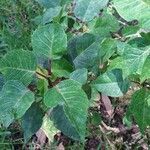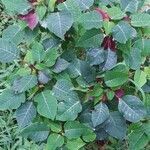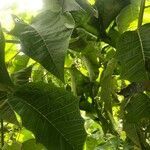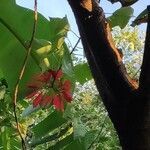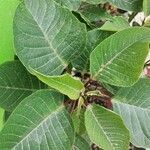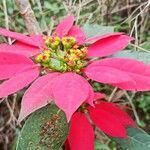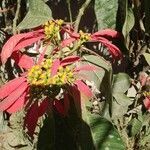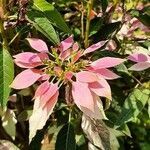Shrubs to small trees, 1-3(-4) m, many branched. Stems glabrous. Leaves alternate; stipules minute, membranous, caducous; petiole 2-5 cm, glabrous; leaf blade ovate-elliptic, oblong, or lanceolate, often shallowly lobed, 6-25 × 4-10 cm, abaxially pubescent, adaxially shortly pubescent or glabrous, base attenuate, apex acuminate or acute. Cyathia in a very congested, 1-sided synflorescence, subtended by 5-7 petiolate leaflike bracts, these narrowly elliptic, 3-7 × 1-2 cm, usually entire, sometimes repand-lobed, scarlet, peduncle 3-4 mm; involucre urceolate, light green, 7-9 × 6-8 mm, lobes 5, lacerate, triangular, glabrous; glands usually 1, rarely 2, yellow, compressed, 2-lipped, 4-5 × ca. 3 mm. Male flowers many, usually exserted from involucre; bracts linear, pilose. Female flower: ovary glabrous, pedicellate, exserted from involucre, smooth; styles connate below middle; stigma deeply 2-lobed. Capsule, 3-lobed-globose, 1.5-2 × ca. 1.5 cm, smooth and glabrous. Seeds ovoid, ca. 10 × 8-9 mm, gray or light gray, subsmooth, without caruncle. Fl. and fr. Oct-Apr.
More
A shrub. It grows about 3.5 m high. The trunk is woody and brown. The branches are angular. The leaves are large. They are oval to sword shaped and have 12 teeth on either side. They are 20 cm long. They taper to the tip. There can be lobes along the edge. It usually drops its leaves as flowering begins. The bracts are large and red. This gives the flower cluster the appearance of one large flower. The bracts can also be white or yellow. The flowers are small and greenish yellow. The fruit is a small capsule with 3 lobes.
